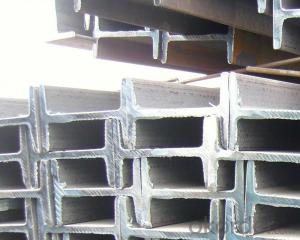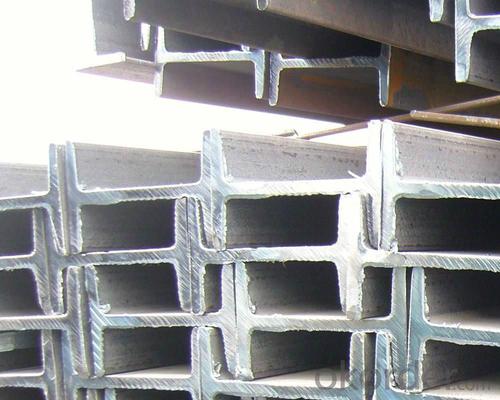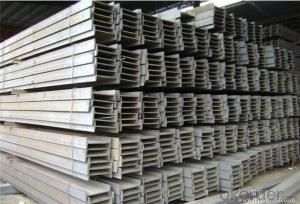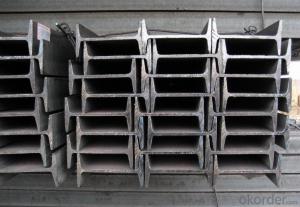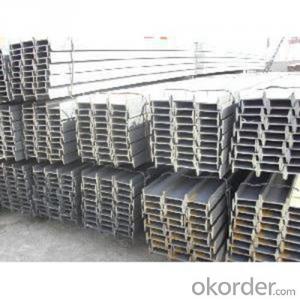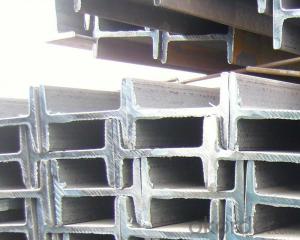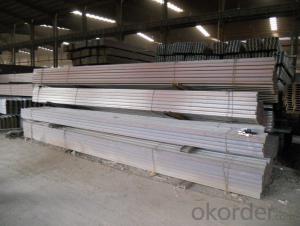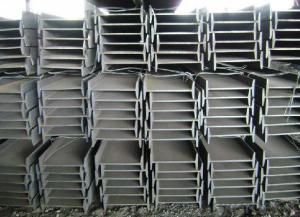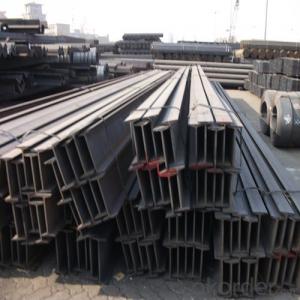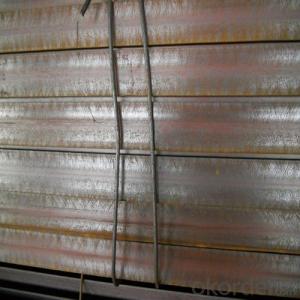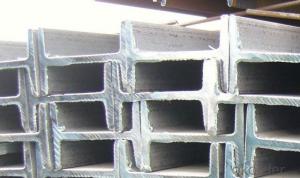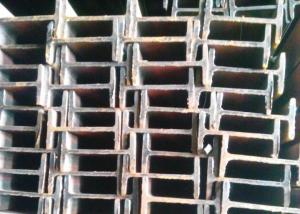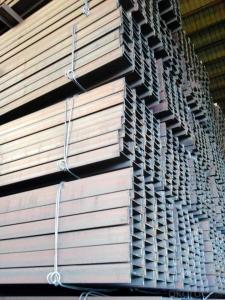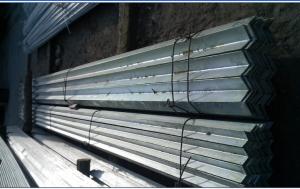I Beam Hot Rolled High Quality GB Q235 3MM-20MM
- Loading Port:
- Tianjin
- Payment Terms:
- TT or LC
- Min Order Qty:
- 25 m.t.
- Supply Capability:
- 20000 m.t./month
OKorder Service Pledge
OKorder Financial Service
You Might Also Like
Product Applications:
Hot Rolled Steel I-Beams are ideal for structural applications and are widely used in the construction of buildings and bridges, and the manufacturing, petrochemical, and transportation industries.
Product Advantages:
OKorder's Steel I-Beams are durable, strong, and resist corrosion.
Main Product Features:
· Premium quality
· Prompt delivery & seaworthy packing (30 days after receiving deposit)
· Corrosion resistance
· Can be recycled and reused
· Mill test certification
· Professional Service
· Competitive pricing
Product Specifications:
Manufacture: Hot rolled
Grade: Q195 – 235
Certificates: ISO, SGS, BV, CIQ
Length: 6m – 12m, as per customer request
Packaging: Export packing, nude packing, bundled
Chinese Standard (H*W*T) | Weight (Kg/m) | 6m (pcs/ton) | Light I (H*W*T) | Weight (Kg/m) | 6m (pcs/ton) | Light II (H*W*T) | Weight (Kg/m) | 6M |
100*68*4.5 | 11.261 | 14.8 | 100*66*4.3 | 10.13 | 16.4 | 100*64*4 | 8.45 | 19.7 |
120*74*5.0 | 13.987 | 11.9 | 120*72*4.8 | 12.59 | 13.2 | 120*70*4.5 | 10.49 | 15.8 |
140*80*5.5 | 16.89 | 9.8 | 140*78*5.3 | 15.2 | 10.9 | 140*76*5 | 12.67 | 13.1 |
160*88*6 | 20.513 | 8.1 | 160*86*5.8 | 18.46 | 9 | 160*84*5.5 | 15.38 | 10.8 |
180*94*6.5 | 24.143 | 6.9 | 180*92*6.3 | 21.73 | 7.6 | 180*90*6 | 18.11 | 9.2 |
200*100*7 | 27.929 | 5.9 | 200*98*6.8 | 25.14 | 6.6 | 200*96*6.5 | 20.95 | 7.9 |
220*110*7.5 | 33.07 | 5 | 220*108*7.3 | 29.76 | 5.6 | 220*106*7 | 24.8 | 6.7 |
250*116*8 | 38.105 | 4.3 | 250*114*7.8 | 34.29 | 4.8 | 250*112*7.5 | 28.58 | 5.8 |
280*122*8.5 | 43.492 | 3.8 | 280*120*8.2 | 39.14 | 4.2 | 280*120*8 | 36.97 | 4.5 |
300*126*9 | 48.084 | 3.4 | 300*124*9.2 | 43.28 | 3.8 | 300*124*8.5 | 40.87 | 4 |
320*130*9.5 | 52.717 | 3.1 | 320*127*9.2 | 48.5 | 3.4 | |||
360*136*10 | 60.037 | 2.7 | 360*132*9.5 | 55.23 | 3 |
FAQ:
Q1: Why buy Materials & Equipment from OKorder.com?
A1: All products offered byOKorder.com are carefully selected from China's most reliable manufacturing enterprises. Through its ISO certifications, OKorder.com adheres to the highest standards and a commitment to supply chain safety and customer satisfaction.
Q2: How do we guarantee the quality of our products?
A2: We have established an advanced quality management system which conducts strict quality tests at every step, from raw materials to the final product. At the same time, we provide extensive follow-up service assurances as required.
Q3: How soon can we receive the product after purchase?
A3: Within three days of placing an order, we will begin production. The specific shipping date is dependent upon international and government factors, but is typically 7 to 10 workdays.
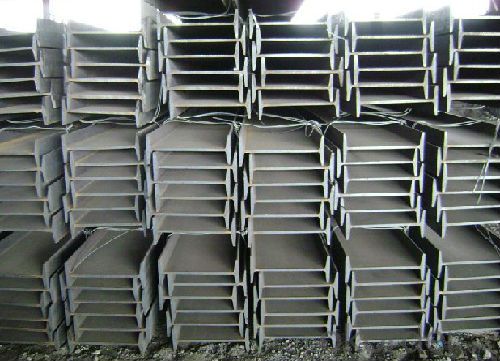

- Q: What are the typical lengths of steel I-beams?
- The typical lengths of steel I-beams can vary depending on the specific application and manufacturer. However, common lengths for steel I-beams range from 20 feet to 40 feet. These lengths are regularly used in construction projects, as they provide stability and structural integrity. Additionally, some manufacturers may offer custom lengths to meet the specific requirements of a project. It is important to consult with engineers and architects to determine the appropriate length of steel I-beams for a given application.
- Q: Are steel I-beams affected by temperature fluctuations?
- Yes, steel I-beams are indeed affected by temperature fluctuations. Steel is a material that expands and contracts with changes in temperature. When exposed to high temperatures, such as during a fire, the steel I-beams can expand, losing their strength and structural integrity. On the other hand, during extremely cold temperatures, steel contracts, which can cause issues such as cracking or brittleness. Therefore, temperature fluctuations can have a significant impact on the performance and stability of steel I-beams in various structures.
- Q: How do steel I-beams handle extreme temperatures?
- Steel I-beams are designed to handle extreme temperatures quite well. The high melting point of steel allows these beams to maintain their structural integrity even in extremely hot conditions. Additionally, steel has a low coefficient of thermal expansion, meaning it expands and contracts minimally with temperature changes, reducing the risk of cracking or warping. Overall, steel I-beams are a reliable choice for structures exposed to extreme temperatures.
- Q: Can Steel I-Beams be used for rooftop gardens?
- Steel I-beams can certainly be used for rooftop gardens. In fact, they are often used as a structural support system for rooftop gardens in urban areas where space is limited. Steel I-beams provide excellent strength and durability, making them capable of supporting the weight of the garden, planters, soil, and any additional infrastructure such as walkways or seating areas. Furthermore, steel I-beams can be easily integrated into the overall design of a rooftop garden, allowing for flexibility in creating different levels or terraces. They also offer stability and resistance to weather conditions, ensuring the garden remains secure even during strong winds or heavy rain. However, it is important to note that the specific design and load-bearing capacity of the steel I-beams should be assessed by an engineer or a qualified professional to ensure they can safely support the intended rooftop garden. Local building codes and regulations should also be considered to ensure compliance and safety. Overall, steel I-beams are a viable option for rooftop gardens, providing a strong and stable foundation for creating beautiful and functional green spaces in urban environments.
- Q: Can steel I-beams be used in airport terminal construction?
- Indeed, airport terminal construction does make use of steel I-beams. These beams, renowned for their strength and durability, are widely employed in the construction industry. They offer a robust framework capable of bearing heavy loads and enduring the structural requirements of extensive undertakings like airport terminals. Furthermore, steel possesses fire-resistant properties and can be conveniently fabricated and erected on-site, rendering it a pragmatic selection for projects with stringent timelines. By incorporating steel I-beams into airport terminal construction, the structure's safety and stability are assured, all the while permitting flexibility in design and construction approaches.
- Q: What is the free length of the compression flange?
- For beams without lateral support points in the midspan, L1 is the span; for the beams with lateral supporting points in the midspan, L1 is the distance between the lateral supporting points of the compression flange (the lateral support of the beam is considered as lateral support).
- Q: What is the cost of Steel I-Beams?
- The cost of Steel I-Beams can vary depending on various factors such as the size, length, and quality of the beams. Generally, the price range for Steel I-Beams can be anywhere from $50 to $200 per linear foot. However, it is important to note that prices can fluctuate based on market conditions, location, and supplier. Furthermore, additional costs such as delivery fees, taxes, and any customization or special requirements can also impact the final cost. Therefore, it is recommended to contact local suppliers or manufacturers for accurate and up-to-date pricing information.
- Q: Which bearing capacity is stronger?
- Under the same thickness, the bearing capacity of I-beam will be better than that of channel steel, and the price of channel steel will be lower than that of i-beam.
- Q: How do you calculate the torsional stiffness of a steel I-beam?
- In order to determine the torsional stiffness of a steel I-beam, one must take into account its geometric characteristics and material properties. The torsional stiffness quantifies the beam's ability to resist twisting when subjected to a torsional load. Initially, one must ascertain the cross-sectional dimensions of the I-beam, including the flange width, flange thickness, web height, and web thickness. These dimensions can be obtained from the beam's specifications or directly measured. Subsequently, the moment of inertia for each component of the I-beam should be calculated. The moment of inertia represents the beam's ability to resist both bending and twisting. For an I-beam, the moment of inertia needs to be calculated for both the flanges and the web. The moment of inertia for the flanges can be determined using the formula I = (b * h^3) / 12, where b denotes the flange width and h represents the flange thickness. This calculation should be performed for both the top and bottom flanges. The moment of inertia for the web can be calculated using the formula I = (w * h^3) / 12, where w denotes the web thickness and h represents the web height. Subsequently, the moments of inertia for all components of the I-beam should be summed to obtain the total moment of inertia. Finally, the torsional stiffness can be determined by employing the formula T = (G * J) / L, where T signifies the torsional stiffness, G represents the shear modulus of elasticity of the steel, J denotes the polar moment of inertia (equivalent to the total moment of inertia for an I-beam), and L represents the length of the beam. By substituting the calculated values into the formula, one can determine the torsional stiffness of the steel I-beam. It is important to note that the torsional stiffness may vary along the length of the beam, so this calculation provides an average value.
- Q: Can steel I-beams be used for conveyor supports?
- Yes, steel I-beams can be used for conveyor supports. Steel I-beams are commonly used in construction and industrial applications due to their strength and durability. They provide excellent load-bearing capabilities, making them suitable for supporting heavy machinery and equipment, including conveyors. The I-beam's design allows for even weight distribution and structural stability, which is crucial for conveyor systems that transport materials over long distances or at high speeds. Additionally, steel I-beams can be easily customized and installed to meet specific conveyor support requirements, making them a reliable choice for conveyor systems in various industries.
Send your message to us
I Beam Hot Rolled High Quality GB Q235 3MM-20MM
- Loading Port:
- Tianjin
- Payment Terms:
- TT or LC
- Min Order Qty:
- 25 m.t.
- Supply Capability:
- 20000 m.t./month
OKorder Service Pledge
OKorder Financial Service
Similar products
Hot products
Hot Searches
Related keywords
